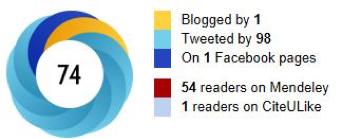Research Metrics
SHURA records for some journal articles and other research outputs, include badges with bibliometrics and alternative metrics at the bottom of the page. These research metrics are present when they are available for the article and when a Digital Object Identifier (DOI) in the SHURA record enables the article to be identified by the service providing the metrics.
Bibliometrics from Dimensions
The Dimensions badge provides information about citations and other bibliometrics relating to the article or other research output. It uses data from the free Dimensions publications database produced by Digital Science.

There are four bibliometrics that may be shown for each record:
- Total citations is a count of the publications in the Dimensions database which cite the work. Clicking on the badge takes you to Dimensions where you can see a list of the citing publications.
- Recent citations is the number of documents in the Dimensions database which have cited the work in the last two calendar years.
- The Field Citation Ratio puts citation counts in the context of the Field of Research assigned to the research in Dimensions. To help you to understand this metric, Digital Science provide information about how Field Citation Ratios are calculated.
- The Relative Citation Ratio is calculated for papers in the fields of biomedical sciences and health and is used by the National Institutes of Health (US). Digital Science provide information about how the Relative Citation Ratio is calculated and links to further information.
Alternative metrics from Altmetric.com
The Altmetrics badge (known as the Altmetrics donut) provides data about attention to the publication on social media such as Twitter and Facebook, and attention in blogs, Wikipedia and news sources. It also provides information about saves to the reference management tools CiteULike and Mendeley.

Clicking on the donut, opens the full 'Altmetrics details page' for the publication. This page helps to provide context for the attention score in the centre of the donut and gives details about who is tweeting about the work.
Understanding metrics and using them responsibly
The Library Research Support web pages on identity and impact provide more information about bibliometrics and alternative metrics as well as ways to manage your identity and raise your researcher profile.
It is import to understand the metrics you see and to use them responsibly. If you are a researcher at SHU, please have a look at our web pages about responsible metrics and read the University's guidance on responsible use of metrics in research assessment. The Metrics toolkit is also a useful source on bibliometrics and altmetrics, including helpful information about their limitations and use cases.

